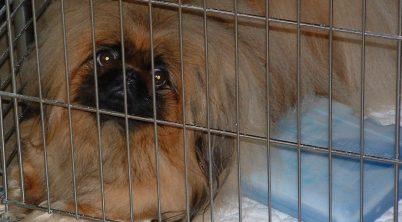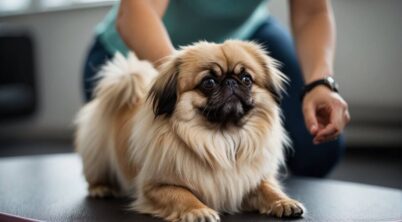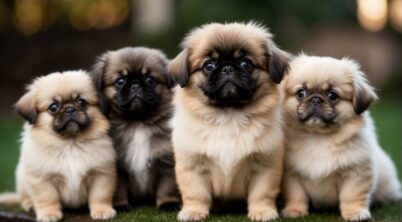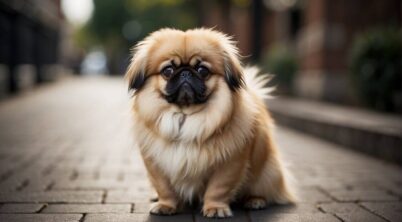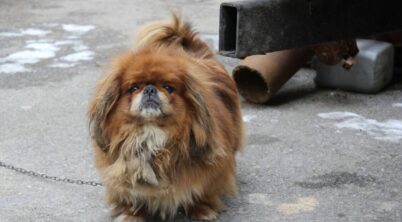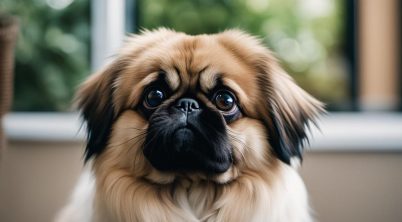Originating from the ancient courts of China, the Pekingese is a breed that boasts a royal legacy. Often referred to as the “lion dog” thanks to its luxuriant mane reminiscent of the regal feline, this toy breed was once the treasured companion of Chinese emperors. The breed’s presence in China dates back over a millennium, and it was so revered that theft of a Pekingese was punishable by death. Their introduction to the Western world is notably tied to the Opium Wars, during which time several dogs were taken from the Summer Palace and presented to Queen Victoria, thus setting the stage for their eventual global popularity.
The Pekingese is easily identifiable by its unique physical characteristics. With a distinctive flat face, large, soulful eyes, and a small, muscular frame, the breed stands out in the realm of toy dogs. Its coat is long, thick, and comes in a variety of colors, often requiring dedicated grooming to maintain its splendor. The breed’s resolute expression mirrors its confident and sometimes imperial demeanor, a nod to its regal Chinese ancestry.
Recognized by the American Kennel Club (AKC), the Pekingese adheres to strict breed standards, particularly regarding size and weight, with the ideal weight not to exceed 14 pounds. The breed holds a special place in the United States’ dog community, further evidenced by the establishment of the Pekingese Club of America, an organization dedicated to the breed’s preservation and welfare. Despite its small stature, the Pekingese leaves a grand impression, embodying centuries of cultural history and charm.
Table of Contents
Pekingese Identifying Features
The Pekingese, often referred to as ‘Peke’, is easily identified by its unique physical characteristics. They have a compact, sturdy body, typically standing about 6 to 9 inches at the shoulder and weighing between 7 to 14 pounds. Despite their small size, they project a self-assured demeanor.
Appearance: Pekingeses sport a lion-like mane around their neck and shoulders, fitting for their nickname, the “lion dog.” They possess a distinctive facial structure with a short muzzle and large, expressive eyes. The breed displays a prominent V-shaped facial wrinkle, contributing to their characteristic expression.
Coat: Their double-layered coat is another standout feature, with the outer coat being coarse and the inner coat being soft and thick. The fur is longer and frames the face and body, enhancing their regal appearance.
Posture and Gait: They are noted for their low body and slightly bowed limbs, which adds to their distinguished presence. The Pekingese gait is typically a rolling amoeba-like motion, exemplifying their dignified stature.
Colors and Markings: The breed comes in various coat colors and may have markings. The fur’s color palette can range greatly, adding to the breed’s individuality.
Temperament: A Pekingese may carry itself with an air of importance — a reminder of its storied history among Chinese royalty. They are often seen as aloof but are known to let down their guard to romp and play. Their alert demeanor makes them reliable watchdogs, capable of a robust bark disproportionate to their size.
Appearance and Physical Characteristics
The Pekingese is a breed renowned for its compact size and lion-like appearance owed to its long, flowing coat and unique facial structure. This toy breed boasts a combination of distinctive features that present a confident and dignified air.
Size and Weight
- Height: 6-9 inches at the shoulder
- Weight: Up to 14 pounds
The Pekingese is a stocky, muscular toy breed that stands 6 to 9 inches tall at the shoulder. Weight is a significant characteristic of the breed, with the ideal being up to 14 pounds. Any dog exceeding this weight may face disqualification in breed conformation shows.
Coat and Color
- Coat Type: Long, dense with a thick mane
- Color Variations: Black, gray, cream, red, sable, tan, white
The breed possesses a long, dense coat that contributes to its regal appearance. Particularly noteworthy is the thick mane, reminiscent of a lion’s, which adds to its noble bearing. Pekingese coats come in a variety of colors, including black, gray, cream, red, sable, tan, and white.
Distinctive Facial Features
- Facial Structure: Brachycephalic, with a short snout
- Ears: Set at eye level, heart-shaped
- Gait: A rolling, distinctive walk
Their brachycephalic facial structure is defined by a short snout and flat face. The Pekingese’s large, expressive eyes are further accentuated by their heart-shaped ears that are level with the eyes. They are recognizable by their rolling gait, a result of their wide, short-legged frame.
Breed History and Origin
The Pekingese breed boasts a rich history deeply rooted in ancient China and later introduced to Western society where it continued to flourish.
Pekingese in Chinese History
The Pekingese, also known as the “lion dog,” hails from ancient China, closely associated with Chinese royalty and Buddhism. It is believed to have originated within the imperial courts and was held in high regard by emperors. The breed’s regal bearing and resemblance to the mythical Chinese lion were so valued that it embodied a symbol of divine right. In Beijing, or historically known as Peking, this breed was a treasure exclusive to the nobility, and ownership was strictly regulated.
Introduction to Western Society
Western encounter with the Pekingese dates back to the Second Opium War in 1860, when British and French forces entered the Yuanmingyuan, the Summer Palace of the Chinese Emperor. During this incursion, five Pekingese dogs were removed and transported back to England. One of these dogs, named Looty, was presented as a gift to Queen Victoria, symbolizing the breed’s formal introduction to Western society. Thereafter, the breed gained popularity among British and European royalty and aristocrats.
Personality and Temperament
The Pekingese breed is characterized by a unique blend of dignity and boldness, displaying traits that reflect both royal ancestry and a spirited canine nature. They are remarkably confident and possess an independent streak that complements their affectionate demeanor towards family members.
Behavioral Traits
Pekingese dogs display a range of behavioral traits that are both endearing and challenging. They are intelligent and alert, often serving as efficient little watchdogs who won’t hesitate to bark authoritatively, belying their small size. Despite their seemingly stubborn and aloof nature, they can exhibit playful behavior and enjoy periods of activity, although they are not exceedingly high-energy dogs. Their temperament may be less predictable than physical attributes, but it is shaped significantly by their upbringing and training.
- Energy Level: Moderate
- Intelligence: High
- Independence: High
- Stubbornness: Moderate to High
- Watchdog Ability: Excellent
Interaction with Family and Pets
When it comes to family life, Pekingese are notably affectionate and loyal. They thrive on attention and are sensitive to the needs and emotions of their household members, forming strong bonds with those they consider family. However, their independent nature sometimes might make them seem distant. As for other pets, socialization plays a crucial role. Pekingese can coexist peacefully with other animals if introduced properly and treated with respect. They are generally not aggressive, but early social interaction is recommended to foster friendliness and mitigate any potential jealousy or territorial behaviors.
- Affection: Highly Affectionate
- Loyalty: Strong
- Family Interaction: Highly Engaged
- Pet Friendliness: Moderate; dependent on socialization.



